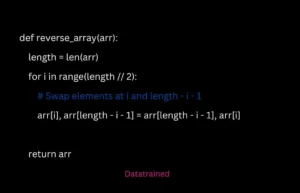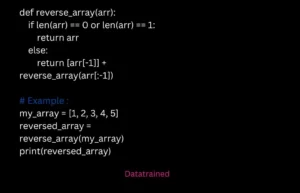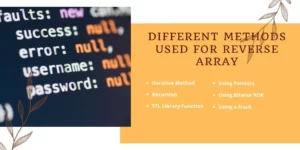Table of Contents
ToggleIntroduction
Reverse an Array easily with our guide! Examples & step-by-step instructions for various programming languages.
Arrays are an essential part of programming and computer science. They are used to store collections of data in a single variable, making it easy to access and manipulate the data. One important operation on arrays is the reverse operation, which involves rearranging the elements of an array in reverse order. In this article, we will take an in-depth look at how to Reverse an Array through two different algorithms, its implementation, time complexity, and practical applications.
Algorithms to Reverse an Array
The reverse array algorithm is a simple yet powerful algorithm that involves reversing the order of the elements in an array. The algorithm takes an array as input and modifies it so that the first element becomes the last, the second becomes the second last, and so on. The reverse operation is a common operation that is used in many applications, such as sorting algorithms, string manipulations, and numerical computations.
The reverse array algorithm can be implemented using various techniques, such as iteration, recursion, and pointers. In the next section, we will discuss how to Reverse an Array using iteration.
Implementation of the Reverse an Array Using Iteration
The Reversing an Array Algorithm can be implemented using a simple iterative approach that involves swapping the elements of the array. The algorithm takes an array as input and modifies it so that the elements are in reverse order.
Here is an example implementation of the Reversing an Array using iteration in Python:
In this implementation, the function takes an array as input and uses a for loop to iterate over the first half of the array. The for loop swaps the elements of the array using a temporary variable, which stores the value of the current element. The algorithm terminates when the loop has iterated over half of the array.
The time complexity of the reverse array algorithm using iteration is O(n), where n is the number of elements in the array. The space complexity is O(1), as the algorithm does not require any additional memory.
Implementation of the Reverse Array Algorithm Using Recursion
The reverse array algorithm can also be implemented using recursion. Recursion is a technique where a function calls itself to solve a problem. Reverse an Array using recursion involves dividing the array into smaller subarrays and reversing them recursively.
Here is an example implementation of the Reverse an Array using recursion in Python:
In this code, the function takes an array “arr” as input and returns the reverse array output.
The function uses recursion to reverse more than one element of an array. The recursive function continues until the base case is achieved.
The time complexity of the reverse array algorithm using recursion is also O(n), where n is the number of elements in the array. Since the algorithm is implemented using recursion, the space complexity of the algorithm is O(n), where n is the number of elements in the array.
Check out:- Best Data Science Course in Pune
Applications of the Reverse Array Algorithm
The reverse array algorithm has many practical applications in programming and computer science. Here are some of the most common applications:
String Reversal: The reverse array algorithm can be used to reverse the characters in a string.
Array Reversal: As discussed earlier, the reverse array algorithm is used to reverse the order of elements in an array. This operation is used in many sorting algorithms, such as the bubble sort and insertion sort.
Numerical Computations: The algorithm can be used in numerical computations, such as computing the inverse of a matrix. The inverse of a matrix is obtained by reversing the order of rows and columns in the matrix.
Image Processing: The algorithm can be used in image processing to flip images horizontally or vertically. This operation is useful in many applications, such as video processing and computer vision.
Audio Processing: Reverse an Array Technique can be used in audio processing to reverse the order of audio samples. This operation is useful in many applications, such as audio editing and music production.
Data Structures: The reverse array algorithm can be used in data structures, such as linked lists and stacks, to reverse the order of elements. This operation is useful in many applications, such as reversing the order of a list or stack.
Parallel Computing: The reverse array algorithm can be used in parallel computing to distribute the reversal of a large array across multiple processors. This can significantly reduce the time required to reverse large arrays and improve the performance of parallel applications.
Cryptography: The reverse array algorithm can be used in cryptography to reverse the order of bits in a binary string. This operation is useful in many encryption and decryption algorithms, such as the Data Encryption Standard (DES) and the Advanced Encryption Standard (AES).
Compression Algorithms: The reverse array algorithm can be used in compression algorithms, such as Huffman coding and Lempel-Ziv-Welch (LZW) compression, to reverse the order of the encoded symbols. This operation can improve the efficiency of compression algorithms and reduce the size of compressed data.
Machine Learning: The Reversing an Array can be used in machine learning to reverse the order of data samples in a dataset. This operation is useful in many applications, such as time-series analysis and sequence prediction.
Text Processing: The reverse array algorithm can be used in text processing to reverse the order of characters in a string. This operation can be useful in many applications, such as reversing the order of words in a sentence or reversing the order of paragraphs in a document.
Cryptocurrency: The concept of Reverse an Array can be used in blockchain technology to reverse the order of transactions in a block. This operation is useful in many cryptocurrencies, such as Bitcoin and Ethereum, to ensure the integrity and security of the blockchain.
Data Analysis: The reverse array algorithm can be used in d
ata analysis to reverse the order of rows or columns in a dataset. This operation can be useful in many applications, such as reversing the order of time-series data or reversing the order of variables in a regression analysis.
Game Development: The reverse array algorithm can be used in game development to reverse the order of game assets, such as sprites or levels. This operation can be useful in many games, such as puzzle games or platformers, to add variety and complexity to the gameplay.
Network Programming: The reverse array algorithm can be used in network programming to reverse the order of packets in a network stream. This operation can be useful in many applications, such as network analysis or troubleshooting.
Natural Language Processing: The reverse array algorithm can be used in natural language processing to reverse the order of words in a sentence. This operation can be useful in many applications, such as sentiment analysis or machine translation.
Compiler Design: The reverse array algorithm can be used in compiler design to reverse the order of instructions in a program. This operation can be useful in many applications, such as optimizing the performance of the program or improving its security.
Robotics: The reverse array algorithm can be used in robotics to reverse the order of commands sent to a robot. This operation can be useful in many applications, such as robot navigation or motion planning.
Signal Processing: The reverse array algorithm can be used in signal processing to reverse the order of a digital signal. This operation can be useful in many applications, such as audio and speech processing or radar signal processing.
Artificial Intelligence: The reverse array algorithm can be used in artificial intelligence to reverse the order of the input data fed to a neural network. This operation can be useful in many applications, such as image recognition or natural language processing.
Database Management: The reverse array algorithm can be used in database management to reverse the order of rows in a database table. This operation can be useful in many applications, such as data analysis or data visualization.
Web Development: The reverse array algorithm can be used in web development to reverse the order of elements on a webpage. This operation can be useful in many applications, such as creating a timeline or a list of events.
Music Production: The reverse array algorithm can be used in music production to reverse the order of audio samples or tracks. This operation can be useful in many applications, such as creating sound effects or adding a unique twist to a musical composition.
Check out:- Best Data Science Course in Delhi
Different Methods Used For Reversing an Array
Iterative Method: The iterative method is the simplest and most straightforward way to Reverse an Array. In this method, we start by swapping the first and last elements of the array, then move towards the center of the array, swapping each element with its corresponding element on the opposite end until we reach the middle of the array. This method has a time complexity of O(n/2) and a space complexity of O(1).
Recursion: The recursive method for Reverse an Array involves dividing the array into two parts: the first element and the rest of the array. We recursively reverse the rest of the array and then swap the first element with the last element. This method has a time complexity of O(n) and a space complexity of O(n) due to the recursive call stack.
STL Library Function: The Standard Template Library (STL) provides a built-in function called “reverse()” that can be used to Reverse an Array. This method is very efficient and has a time complexity of O(n), but it requires the inclusion of the STL library and is not as straightforward as the other methods.
Using a Stack: We can also use a stack data structure to Reverse an Array. In this method, we push all the elements of the array onto the stack and then pop them one by one to get the reversed array. This method has a time complexity of O(n) and a space complexity of O(n) due to the stack data structure.
Using Pointers: We can also use pointers to Reverse an Array. In this method, we use two pointers, one pointing to the first element of the array and the other pointing to the last element of the array. We swap the elements pointed by the two pointers and then move the pointers toward the center until they meet. This method has a time complexity of O(n/2) and a space complexity of O(1).
Using Bitwise XOR: We can also use the bitwise XOR operator to Reverse an Array. In this method, we XOR each element of the array with its corresponding element from the opposite end, starting from the first and last elements and moving toward the center. This method has a time complexity of O(n) and a space complexity of O(1).
Overall, the choice of method depends on the specific requirements of the application, such as time and space complexity constraints, ease of implementation, and the need for built-in library functions.
Conclusion
The reverse array algorithm is a simple yet powerful algorithm that involves reversing the order of elements in an array. The algorithm can be implemented using various techniques, such as iteration, recursion, and pointers. The time complexity of the algorithm is O(n), where n is the number of elements in the array, and the space complexity is O(1) or O(log n), depending on the implementation technique.
The reverse array algorithm has many practical applications in programming and computer science, such as string reversal, array reversal, numerical computations, image processing, audio processing, and data structures.
As such, the reverse array algorithm is an essential operation in the programmer’s toolbox, and understanding its implementation and applications can lead to more efficient and effective coding practices.
Frequently Asked Questions
How do I reverse an array in Python?
In Python, you can reverse an array using the slicing technique.
Here’s an example:
array = [1, 2, 3, 4, 5]
reversed_array = array[::-1]
The [::-1] part slices the array starting from the beginning to the end, but with a step of -1, which effectively reverses the order of elements in the array.
How can I reverse an array in Java?
In Java, you can reverse an array by swapping elements from both ends until you reach the middle of the array. Here’s an example:
void reverseArray(int[] array) {
int start = 0;
int end = array.length – 1;
while (start < end) {
int temp = array[start];
array[start] = array[end];
array[end] = temp;
start++;
end–;
}
}
This code uses two pointers, start and end, initialized to the beginning and end of the array respectively. It swaps the elements at these positions and continues moving towards the center of the array until they meet.
How can I reverse an array in C++?
In C++, you can reverse an array using the reverse function from the <algorithm> library. Here’s an example:
#include <algorithm>
#include <iostream>
using namespace std;
int main() {
int array[] = {1, 2, 3, 4, 5};
int length = sizeof(array) / sizeof(array[0]);
reverse(array, array + length);
for (int i = 0; i < length; i++) {
cout << array[i] << ” “;
}
return 0;
}
The reverse function takes two iterators representing the range of elements to be reversed. In this case, array and array + length specify the entire array. The function reverses the order of elements in the specified range.


















